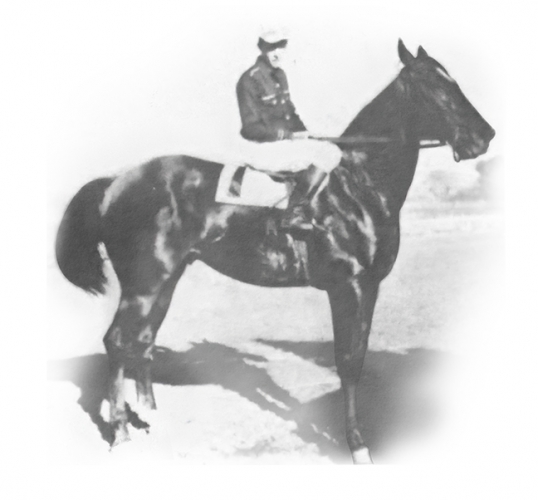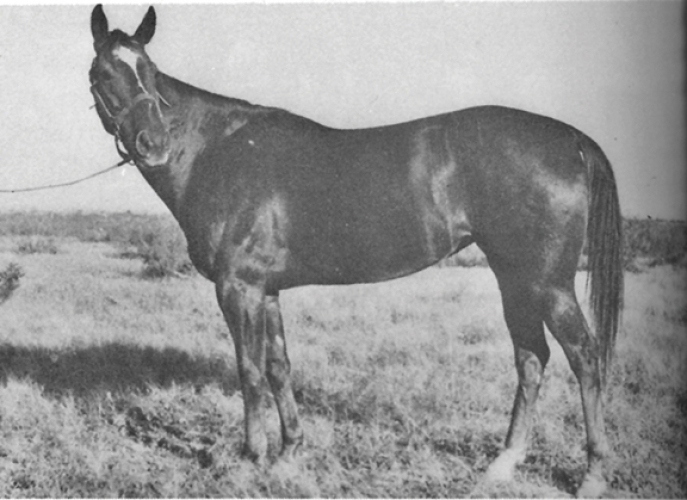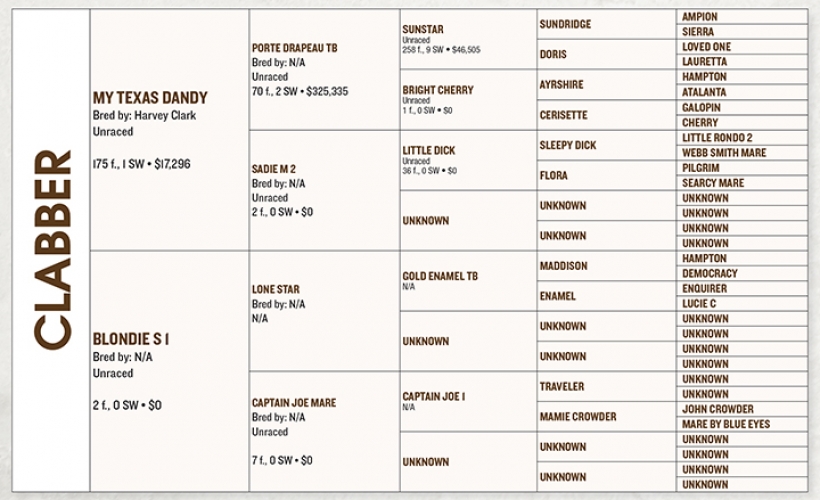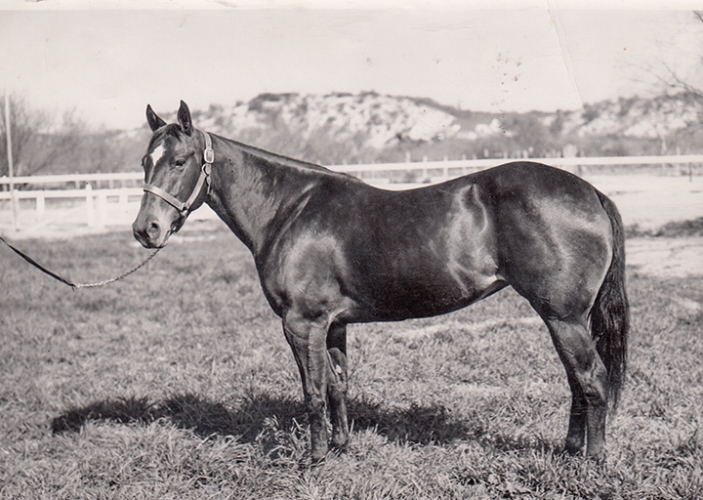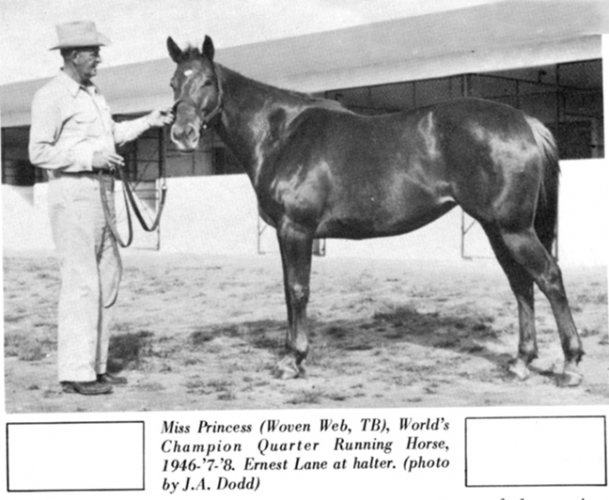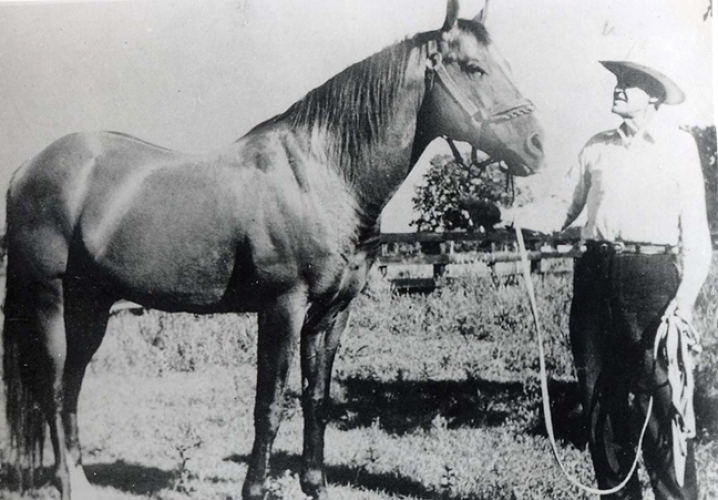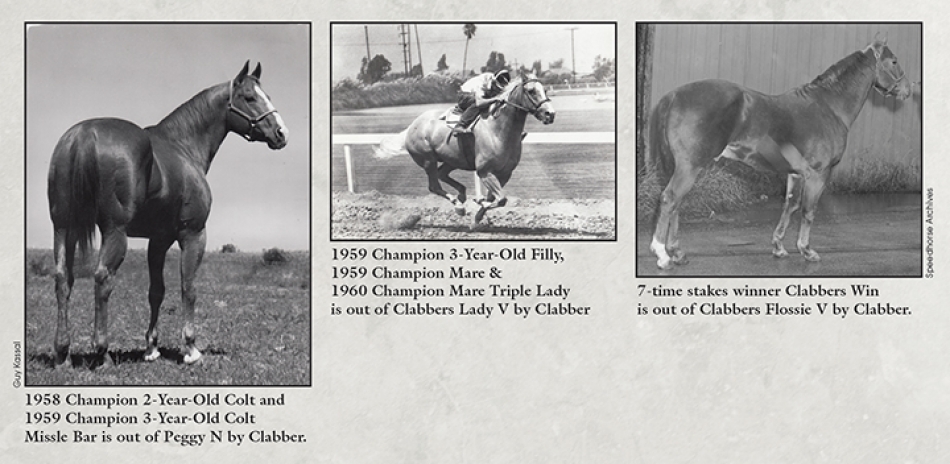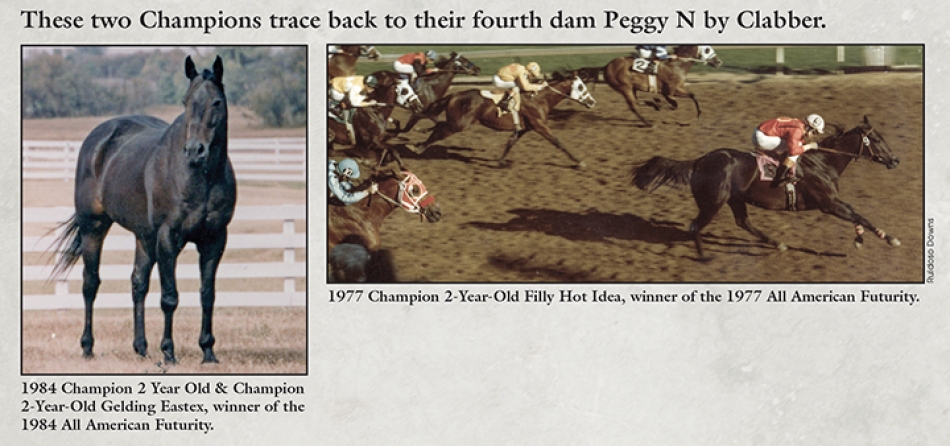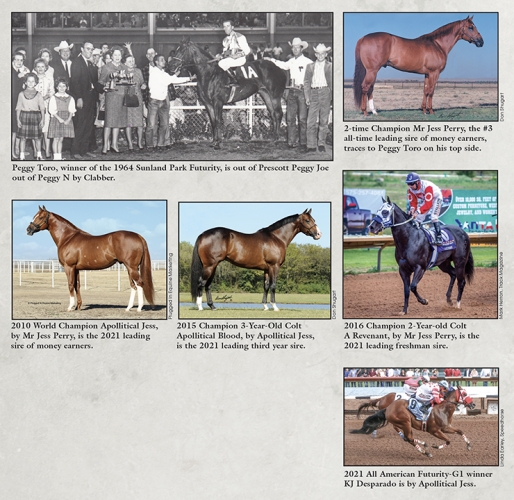
Clabber the Iron Horse
by Larry Thornton
During 2021, we saw and experienced a great year of racing, flirting with everything from two potential triple crown winners at Ruidoso Downs to a horse that traveled to a number of tracks meeting all competition and adding to his racing credentials. It has been a good year for racing – and a great year for Danjer, who was recently named the 2021 AQHA World Champion. Such a title marks the top horse to represent the success of a racing season.
With that in mind, I thought we should look back at Clabber, the first racing World Champion, and see some of the roots that helped form modern racing.
Clabber was the first Racing World Champion, winning his title in the 1940/41 racing season. The races that were used to consider this championship were run in late 1940 and early 1941. Clabber was the racing Champion Stallion, and the legendary Shue Fly was the racing Champion Mare. Clabber was the only stallion to earn the title of World Champion from 1940 to 1949.
It appears that Clabber was lucky to be named the World Champion. Let me show you what I mean. Shue Fly was named the Racing World Champion in 1941/42, with Nobody’s Friend earning the tile of Racing Champion Stallion. This was the first of three World Championships and Champion Mare titles for Shue Fly, with Joe Reed II named the Champion Stallion in 1942/43 and Piggin String and Texas Lad being named the 1943/44 Racing Co-Champion Stallions. No horse was named the Racing World Champion in 1944/45, with a special award being given to Flying Bob as the sire of the Racing Champion Mare Queenie and the Racing Champion Stallion Dee Dee for that racing season. Queenie came back the next year and won the 1945/46 Racing World Championship and Champion Mare titles. Piggin String was the Racing Champion Stallion for the year. Woven Web, who raced as Miss Princess on the Quarter tracks, dominated as the Racing World Champion for the next three years (1946 to 1948) and the racing champion stallions were Hard Twist in 1945/46; Pelican in 1947; and Scooter W in 1948. Maddon’s Bright Eyes was the 1949 Racing World Champion, with the Champion Stallion being Diamond Bob by Flying Bob. The 1950 Racing World Champion was Blob Jr, with Maddon’s Bright Eyes serving as the Champion Mare. In 1951 it was mares back as the World Champion title holders. Maddon’s Bright Eyes and Monita were the Racing Co-World Champions with Bart B S, Hard Twist and Clabbertown G being named Co-Champion Stallions. It has to be noted that there were no aged divisional racing Champions for colt, filly or gelding named during these years. It sure looks like the first few years of organized racing was a woman’s world.
When you look at the history of Clabber, you find a horse that had an interesting life to earn the World Championship but also how he became an influential sire. It is one of those stories of “how the good die young” as Clabber was born 1936 and died in 1947.
Frank Smith of Big Foot, Texas, was the breeder of Clabber. His sire was My Texas Dandy, and his dam is listed in the AQHA as Blondie S by Lone Star. The AQHA shows that Clabber was purchased as a two year old by A. A. “AB” Nichols of Gilbert, Arizona. Nichols made him a ranch horse, trained rope horse, racehorse and sire.
AB Nichols believed that you had to work to keep your place on the ranch, and that was for men and horses alike. Nelson Nye in his article “Clabber—The Great Quarter Horse” that appeared in the November 1951 Western Horseman explained it this way. “AB Nichols was a racehorse man of the old school who scoffed at bandages and workouts, liniments and rubs. Every man on AB’s spread was expected to do a full day’s work every day–and he exacted just as much from his horses. Clabber did his full share from dawn till dark; he became an all-around cow horse in mighty short order. He was used for cutting and roping, he was used to head cattle. He probably headed more cattle one spring for AB Nichols than most cow horses ever do in a lifetime. He was used in rodeo and won a lot of prize money. He was a pretty smart cookie, the pride of the outfit.”
“In between his other chores he did stud service. All manner of mares were brought to his court, few of them better than a shade above sorry; yet from almost all of them he got horses that could run. Quite a number of his get ran themselves into the Register of Merit, and his grandsons and granddaughters are still doing that today.”
Clabber the racehorse was open to the world as a match racehorse, and so we really don’t have an accurate race record. The AQHA computer records don’t even show him to have an official race record. He did get his racing ROM in 1941 and was an AA rated runner, which was the top rating during this time in racing, to go along with his AQHA Racing World Champion and the AQHA Racing Champion Stallion titles.
We will let Nye tells us about the racing career of Clabber and what kind of racehorse he was. “He was officially named World’s Champion Quarter Running Horse for the 1940-1941 season, having defeated such outstanding contenders as Nobody’s Friend, Balmy L, Little Joe Jr., and the Hepler Brothers’ War Chief–just about as tough company as there was on the tracks.”
Nobody’s Friend was bred and raced by the King Ranch. Balmy L was bred by O. W. Cardwell, the last owner of the famous Little Joe who was the broodmare sire of Balmy L. The runner Little Joe Jr was a son of Joe Bailey P-4, and he became a noted broodmare sire with daughters like Ariel Lady, dam of several ROM runners including Raza, the dam of Bull Rastus. War Chief was a son of Joe Hancock, and his owner was the Hepler Brothers who raced the great Shue Fly.
“Clabber was a veteran of the quarter tracks. At Eagle Pass he once ran and won two races in one day. He’d already done this a couple of times in Arizona under somewhat different circumstances. At Eagle Pass he had to win the first quarter miler in 23.0 or better to qualify for running in the big race of the meet. He won the first race as specified and then came back and won the third, which was the big one, against the top runners of the time.
“He has officially been credited with a time of 22.8 for the quarter; at Moltaqua he set a track record going 350 yards in 18.4. He may not have been the fastest horse, but he was a real hard knocker who could do about everything a Quarter Horse is asked to. He got no pampering of any sort. More than a few of his races were run under an impost of 135 pounds, and he furnished competition at any distance.”
An added note: Moltaqua was better known as Hacienda Moltaqua and was the track that the first organized quarter races were run by the Southern Arizona Horse Breeders Association. This association later evolved into the American Quarter Racing Association that eventually became the racing department of the AQHA.
“Clabber was not invincible. He was beaten by such speedsters as Shue Fly, Joe Reed II, Red Man, Cyclone, and Arizona Girl. He never gave up and made it a horse race every inch of the way. It took a good horse to beat him. It is told that he ran and won three quarter mile races on the same day in Texas, finishing each of them in 23 flat.
“He was still doing some running in 1944. He won two matched races from Painted Joe and, in the stallion race of that year, he ran a dead heat with Bartender in the extremely poor time of 24.2. This race told the story; he was through with the tracks. But he was not washed up by a long shot.”
Frank Vessels bought Clabber in 1944, and brought him to California. As the story goes, Vessels saw Clabber run and he reported the following story. “They were using Clabber as a stock horse, roping cattle and riding in fairs and doing various other things on cattle ranches. He would stand in the gate and since he had been a roping horse, they would run a rope from the rear alongside one side and through the reins in the bit and back on the opposite side to the rear in order to hold him straight in the gate. When the gate would break, they’d hold onto one end of the rope and pull it out of the bridle reins.”
He continued, “When I was there, something happened, and they did not pull the rope. He ran the quarter of a mile with the rope standing straight out in the back and won the race.”
This is the race that Nelson Nye reports in his book Speed And The Quarter Horse that won him his world championship. Nye recounted the story this way, “…He and War Chief a (Hancock bred horse) each packed 135 pounds. Third horse in the race was Little Joe Jr., carried an impost of 130. Clabber, to quote the official statement, ‘was bad in the gate and it took two men to hold him there with a rope through the bit. When the flag was dropped, he lunged and jerked the rope away from the handlers, throwing himself off balance so that he was virtually left at the post. But he recovered himself and won the race with the rope still streaming from the bridle.’ This start was from an open gate set back of line—time taken from the flag. Because of this type start, the time of :22 2/5 cannot be considered as a record.”
The pedigree of Clabber aids the persona of this horse. His sire was My Texas Dandy, a very fast horse that couldn’t win a race. My Texas Dandy was bred by C. F. Meyers of Ellenger, Texas. He owned the mare Sadie M, a daughter of Little Dick. Little Dick was sired by Sleepy Dick by Little Rondo by Sykes Rondo, and his dam was Flora by Pilgrim. Sadie M was out of a mare named Nellie by Panmure. Sadie M was described in the National Quarter Horse Breeders Association magazine The Quarter Horse article “The Story of My Texas Dandy” from October 1948 as a mare that “could run a fast five-eighths.”
Meyers took Sadie M to be bred to Porte Drapeau, who was believed to be imported from France. But his breeder was Jack Joel, an English mining magnet with mines in South Africa, and the family was the owner of the Diamond Mining Company in South Africa. The records show that Porte Drapeau was imported to the United States as a yearling, and he was unraced.
The sire of Porte Drapeau was Sunstar, a horse owned and bred by Joel. Sunstar won The English Derby in 1911 for Joel. Sunstar was sired by Sundridge by Amphion and out of Sierra by Springfield. Sundridge won the July Cup, an important 6-furlong race three times and his broodmare sire Springfield won it twice. The dam of Sunstar was Doris by Loved One. The dam of Porte Drapeau was Bright Cherry by Ayrshire by Hampton and Bright Cherry’s dam was Cerisette by Galopin.
In 1925 Porte Drapeau was owned by Dr. A. I. Clark of Schulenberg, Texas, and my AQHA Stud Book Shows that My Texas Dandy was bred by Dr. Harvey Clark of Schulenberg. But, The Quarter Horse story has photos of those involved and they say that C. F. Meyers owned Sadie M. They tell us that Meyers was both a Quarter Horse and Thoroughbred breeder. Sadie M was one of his quarter mares. The colt born to Sadie M and Porte Drapeau was then a Quarter Horse named Boy Howdy. When it came time to start Boy Howdy and his Thoroughbred herd mates, Meyers sent the Thoroughbreds to race and sell in Louisiana. He kept Boy Howdy in Texas.
A Thoroughbred colt named My Dandy by Porte Drapeau was born in 1925. This horse would go to the track to earn $137,923 running in 191 races from 1929 to 1933. He placed in 16 stakes races until it was time to retire this good runner in 1933. He won nine stakes races, including the Windy City Handicap, George Washington Handicap, and the Speed Handicap. The article tells us that My Dandy had two effects on the state of Texas. Porte Drapeau left Texas and Howdy Boy got a name change to My Texas Dandy because of My Dandy.
When it came time to run My Texas Dandy, a peculiar thing happened. He was sent to Dr. Henry Mayer and a trainer named Charley Brenham. They raced the colt at New Braunfels and La Grange, but he failed to win a race. He showed early speed and blew the competition away from the start, but was overtaken by those chasing him. His jockey Will Hysaw explained it this way because they didn’t always run on a straightaway track but an oval, “He’d get to running so fast in the straightaway that he couldn’t make a turn. He would run right through the fence if you didn’t pull him in. He’d make a wide turn and then be out of the race. If the tracks had been straightaways, then nothin’ could have caught him ‘cause he started like a shot but just ran blind.”
J.C. Smith bought My Texas Dandy in 1929. Clyde Smith was a breeder from Big Foot, Texas, and he was the father of J.C. He didn’t think much of his son’s purchase until he saw My Texas Dandy race and he saw the speed he had, but that he continued to lose his races. Smith had three reasons for the cause of the horse’s problem. First, “he scared himself—that is how fast he could go.” Second, he had a “bad scar on his leg” and that could have resulted in pain when he ran full out despite that the wound had completely healed. Third he “lost interest” in racing and so he just didn’t try to win. No matter the reason, My Texas Dandy reportedly won only one race and in that race the jockey had to force him to run.
Smith repeatedly saw My Texas Dandy “break from the post so fast he made it look as though the other horses had gotten a bad start.” The colt would go down the track and pass everybody and then get beat. He even saw him go down on his knees in one race and get up and catch the field at two hundred yards and still get beat.
When Clyde Smith saw what he had, they started breeding mares to My Texas Dandy. Some of the early foals sired by My Texas Dandy include Colonel Clyde, Ginger Rogers and Captain White Socks, who was a full brother to Clabber. Colonel Clyde may be the most famous as he became a successful runner. He changed hands several times, including time with AB Nichols. He later became a top rodeo horse for the legendary John Bowman. Bowman and Nichols both raced Colonel Clyde and they told Nelson Nye in his book Outstanding Modern Quarter Horse Sires that he could outrun Clabber at “one-eighth of mile,” but that Clabber would win beyond that distance. Bowman ran the horse “open to the world” at one-eighth of a mile. Nye says that the last time Bowman raced him it was a match against a horse named “The Pig” for $1,000 a side. Clyde won by a half-length. Colonel Clyde sired fast runners, including a mare named Prissy that was consider one of the best of her generation. She set a world record for 350 yards in 1946 going in a time of :18.2. She sadly died in a racing accident at Eagle Pass that killed her and her jockey.
My Texas Dandy changed ownership several times to a Mr. Winn and then to Carroll Thompson. Mr. Winn was the owner of Ginger Rogers, one of the early successful runners for My Texas Dandy. Outside the fact that she is sired by My Texas Dandy, she has no reported race or pedigree record.
Thompson sold My Texas Dandy to George Herndon, his last owner and this takes us to some of the later foals sired by My Texas Dandy. They include Battle Creek, a stakes winner in the 1949 Baby Stakes, and My Texas Dandy Jr, the winner of eight of his nine official starts and it appears his only defeat was in the 1947 Del Rio Championship. My Texas Dandy Jr proved to be a sire with foals like Barbara Tex, dam of Dick Killian, the winner of the Arizona Futurity and Miss Lou Dandy, dam of Miss Louton the 1958 AQHA Racing Champion Two-Year-Old Filly and the 1959 AQHA Racing Champion Mare and Three-Year-Old Filly.
Texas Dandy is one of the more prominent sons of My Texas Dandy. He was AAA on the track, and he became the senior sire for the Finley Ranches of Arizona. He sired foals like Little Egypt, the first AAA/AQHA Champion and a stakes winner. She was the 1952 AQHA Honor Roll Racehorse. He also sired Dandy Doll, an AA rated mare that was the dam of Doc Bar, the legendary performance horse sire. The daughters of My Texas Dandy include Nancy Hance, dam of Enhanced an AQHA Supreme Champion.
Blondie S, one of the Frank Smith’s mares, was bred to My Texas Dandy to produce Clabber. She was sired by Lone Star by Gold Enamel. Her dam was Emory Goldman by Captain Joe. This pedigree is the official pedigree. But there are other versions of the pedigree. The volume one of the AQHA Stud Book says that the dam of Clabber was a mare named Golden Wheel by Uncle Jimmy Gray. This was later corrected to Golden Girl. The AQRA listed the dam of Clabber to be Golden Girl, a granddaughter of Possum, the full brother to Little Joe. Possum and Little Joe were sired by Traveler.
How Clabber got his name is an interesting part of the story. His full brother Captain White Socks liked soured milk or ‘clabber’ as it is called. The making of clabber was common at one time and Clabber may have liked it, too. He got the name while AB Nichols owned him, and it was Nichols who registered him.
Clabber, The Sire
The AQHA shows that Clabber has 116 foals listed in the registry. This includes 34 that are either not registered or were registered in the National Quarter Horse Breeders Association, and they were not transferred to the AQHA when the two organizations came together. He sired 52 official race starters with 27 official ROM, four stakes winners and four stakes placed foals. His stakes winners include: Flicka L, winner of the 1946 Arizona Derby; Tess S, winner of the 1950 Speed Handicap; and Sight Unseen, winner of the 1951 Bay Meadows Invitational Handicap.
When we look at the sire record for Clabber, two breeders stand out and they are Chester Cooper of Roosevelt, Arizona, and of course Frank Vessels and his Vessels Stallion Farm. We find Cooper in the early years of Clabber’s sire record and when we look at the produce record of his mares, we see that he not only liked breeding to Clabber, but also to his full brother Captain White Socks and his paternal half-brother Colonel Clyde. You will recall that Prissy was sired by Colonel Clyde, and she was out of Dutchess by Doc. She was bred by Cooper.
The next horse we will look at is Buster Boy, bred by Cooper and that follows this pattern. This Clabber colt ran 45 official races with 16 wins, 11 seconds and 8 thirds. He was stakes placed in the 1950 Big Hat Purse Stakes. The part of his AQHA record that stands out was his setting four track records at distances from 220 yards to 440 yards. The dam of Buster Boy was Phoebe C by Doc and out of Silver by Blue Eyes.
Twilight C is a daughter of Clabber out of Phoebe C and bred by Cooper. She is the dam of Little Orphan Annie, dam of several ROM runners including the stakes placed Stormy Streak, second in the AQRA Laddie Stakes, and Clabber’s Orphan, second in the Gila County Futurity. Clabber’s Orphan is sired by Clabber Charge, who was out of Sugar Hill by Clabber II by Clabber. This gives Clabber’s Orphan a breeding pattern of 4 X 3 to Clabber.
Cooper bred and owned the mare Peggy Cooper, a full sister to Phoebe C. Peggy N by Clabber was the first registered foal out of Peggy Cooper. The produce record for Peggy N shows that she was the dam of 12 foals with nine starters, eight ROM, four stakes winners and one AQHA Racing Champion. The stakes winners include: Clabber Bar, winner of the Gold Bar Handicap; No Comment, winner of the Thunderbird Holiday Championship; and Missle Bar, stakes winner of six stakes races including the 1958 Arizona QHBA Futurity and the 1959 Bay Meadows Championship. Missle Bar was the 1958 AQHA Racing Champion Two-Year-Old Colt and the 1959 AQHA Racing Champion Three-Year-Old Colt.
The fourth stakes winner was Miss Hijo Peggy, winner of the 1963 Bar None Stakes. She is the dam of the stake’s winner Hijo The Man, winner of the 1977 Presidential Futurity, and the race winning mare Peggy Pueblo, dam of Tall Cotton. Tall Cotton is the dam of 1984 All American Futurity-G1 winner Eastex, a racing Champion gelding at two and three.
Be Sure Peggy, a daughter of Peggy N, produced the mare Coquette, and she was the dam of Hot Idea the winner of the 1977 All American Futurity-G1. Prescott Peggy Joe is another daughter of Peggy N, and she is the dam of Peg Be Sure, dam of Sure Blaze the dam of Farmington, winner of the Lubbock Downs Spring Futurity, and My Name Is Alice, winner of the Juarez Derby 3rd Division
Prescott Peggy Joe is the dam of Peggy Toro, a stakes winner in the 1964 Sunland Park Futurity. Peggy Toro has probably made the most significant contribution to racing from this family. She is the dam of Easy Six, the sire of Streakin Six, the sire of Streakin La Jolla, who is the sire of Mr Jess Perry, the #3 all time leading sire of money earners with earnings of over $59 million. Mr Jess Perry is the sire of Apollitical Jess, the 2021 Leading Sire of money earners of over $9 million including the 2021 All American Futurity winner KJ Desparado. Mr Jess Perry is also the sire of A Revanent, the 2021 Leading Freshman sire with progeny earnings of $1,184,494. Apollitical Blood, a son of Apollitical Jess, is the 2021 Leading Third Year sire with earnings of $4,180,239.
The second foal out of Peggy Cooper was Tonta Gal by Clabber. She was a race winner of 14 of her 23 starts. She became the dam of Tonto Bars Gill, the 1952 AQHA Racing Champion Three-Year-Old Colt. Tonto Bars Gill sired two AQHA Racing Champions: Tonto Bars Hank, the 1960 All American Futurity winner and the AQHA Racing Champion Two-Year-Old Colt and Champion Stallion and the 1961 AQHA Racing Champion Three-Year-Old Colt; and Miss Louton, the 1958 AQHA Racing Champion Two-Year-Old Filly and the 1959 AQHA Racing Champion Mare and the Champion Three-Year-Old Filly. We mentioned Miss Louton earlier when we saw her dam Miss Lou Dandy when we profiled the foals of My Texas Dandy Jr. So, Miss Louton was sired by Tonto Bars Gill and out of Miss Lou Dandy by My Texas Dandy Jr. This gives Miss Louton a breeding pattern of 4 X 3 to My Texas Dandy. Miss Louton is the dam of Camptown Girl, and she is the dam of Town Policy, the great racing gelding that was the 1977 AQHA Racing Champion Two Year Old, Champion Two-Year-Old Gelding and the 1978 Champion Three-Year-Old Gelding.
So far, we have looked at Clabber and how he came to win his world’s championship title and his first few years as a sire. When we have an opportunity to return to Clabber, we will look at the role Clabber played in the foundation of the Vessels Stallion Farm along with a mare named Do Good.

